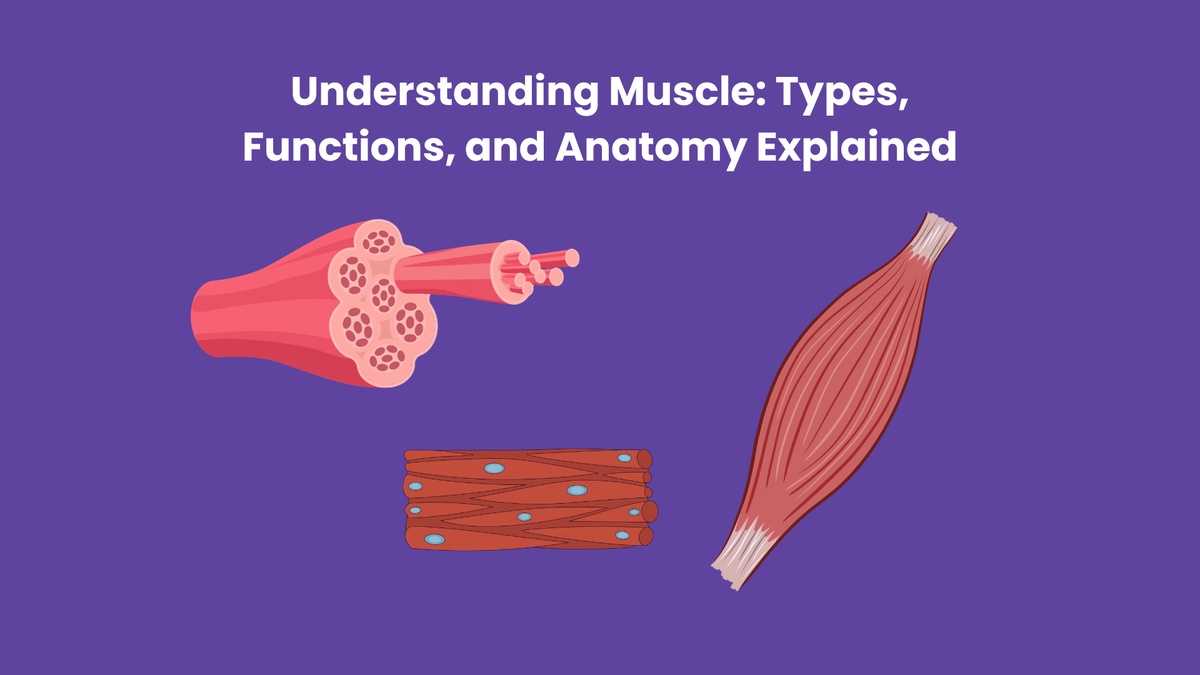Muscles are incredible and vital components of our bodies that enable us to move, maintain posture, and perform various functions. Whether you're lifting weights, running a marathon, or simply picking up a cup of coffee, your muscles are hard at work. In this blog, we will explore the world of muscles, delving into their types, functions, and anatomy to answer the fundamental question: What is Muscle?
What is Muscle?
Muscles are contractile tissues in the human body that generate force and movement. They are composed of muscle fibers, each of which contains myofibrils consisting of proteins like actin and myosin. When stimulated by nerve impulses, these proteins interact, causing the muscle to contract and generate force.
Types of Muscle
There are three main types of muscle in the human body: skeletal, smooth, and cardiac muscles. Each type serves distinct functions and exhibits unique characteristics.
Skeletal Muscle
Skeletal muscles, also known as striated or voluntary muscles, are the most abundant and easily recognizable type of muscle. They attach to bones and are responsible for voluntary movements, such as walking, running, and lifting weights. These muscles are under conscious control, meaning you can decide when to contract and relax them. Skeletal muscles appear striped or striated under a microscope, which is a result of the orderly arrangement of their protein filaments.
The contraction of skeletal muscles is driven by the nervous system. When your brain sends signals to contract a specific muscle, motor neurons transmit electrical impulses to stimulate muscle fibers. This interaction results in the shortening of the muscle, causing movement.
Smooth Muscle
Smooth muscles, also known as non-striated or involuntary muscles, are found in the walls of internal organs, blood vessels, and the digestive system. They are not under conscious control and contract involuntarily. Smooth muscles have a more uniform appearance under a microscope, lacking the striped pattern seen in skeletal muscles.
The function of smooth muscles varies depending on their location. For example, they help propel food through the digestive tract, regulate blood flow by constricting or dilating blood vessels, and control the size of airways in the respiratory system.
Cardiac Muscle
Cardiac muscle is unique to the heart and enables it to pump blood throughout the body. It shares some similarities with both skeletal and smooth muscles. Like skeletal muscles, cardiac muscles are striated, but they are involuntary, like smooth muscles. They contract rhythmically and continuously to maintain a constant blood flow.
The structure of cardiac muscle is designed to facilitate coordinated contractions. Cells are interconnected by specialized junctions called intercalated discs, allowing electrical signals to travel quickly and efficiently between cells. This synchronization ensures that the heart functions as a pump, delivering oxygen-rich blood to the body's tissues.
Functions of Muscles
Muscles serve a wide range of essential functions beyond just facilitating movement. Here are some key functions of muscles in the human body:
- Movement: As mentioned earlier, skeletal muscles enable voluntary movements like walking, running, and lifting objects. Without muscles, we would be immobile.
- Posture: Muscles work together to maintain proper posture and balance, preventing us from slumping over or falling.
- Heat Generation: Muscle contractions produce heat as a byproduct, helping to regulate body temperature. When you shiver, for example, your muscles are generating heat to keep you warm.
- Protection: Muscles, particularly in the abdominal region, provide protection to vital organs. They act as a natural shield, helping safeguard organs from injury.
- Circulation: The contraction of cardiac muscles in the heart powers the circulation of blood, ensuring oxygen and nutrients are delivered to cells and waste products are removed.
Muscle Anatomy
To understand muscles better, it's essential to explore their anatomy in more detail.
- Muscle Fibers: Muscle fibers are the basic building blocks of muscles. These long, cylindrical cells contain myofibrils, which are the contractile units responsible for muscle contractions.
- Tendons: Tendons are tough, fibrous connective tissues that attach muscles to bones. They transmit the force generated by muscle contractions to move the bones, allowing for joint movement.
- Fascia: Fascia is a connective tissue that surrounds muscles, providing support and protection. It also plays a role in muscle coordination and movement.
- Blood Supply: Muscles require a robust blood supply to deliver oxygen and nutrients and remove waste products. Blood vessels, including arteries and veins, run through muscles to ensure proper circulation.
- Nerves: Nerves innervate muscles, sending signals from the brain and spinal cord to initiate muscle contractions. Each muscle has a motor neuron responsible for controlling its movements.
Conclusion
Muscles are complex and multifunctional tissues that play a crucial role in our daily lives. Understanding the different types of muscles, their functions, and their anatomy helps us appreciate their significance in maintaining our overall health and mobility. Whether you're an athlete striving for peak performance or simply going about your daily activities, your muscles are working tirelessly to make it all possible. So the next time you wonder, "What is muscle?" remember that it's not just about lifting weights; it's about the intricate machinery that keeps us moving and thriving.


No comments yet